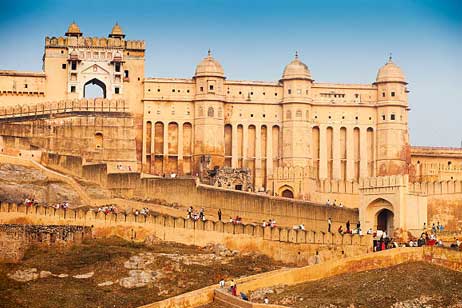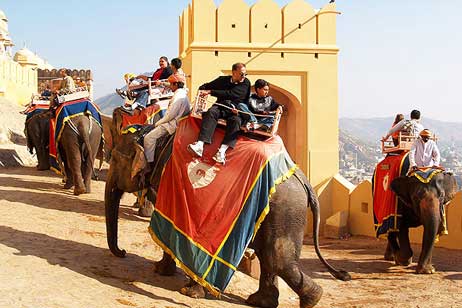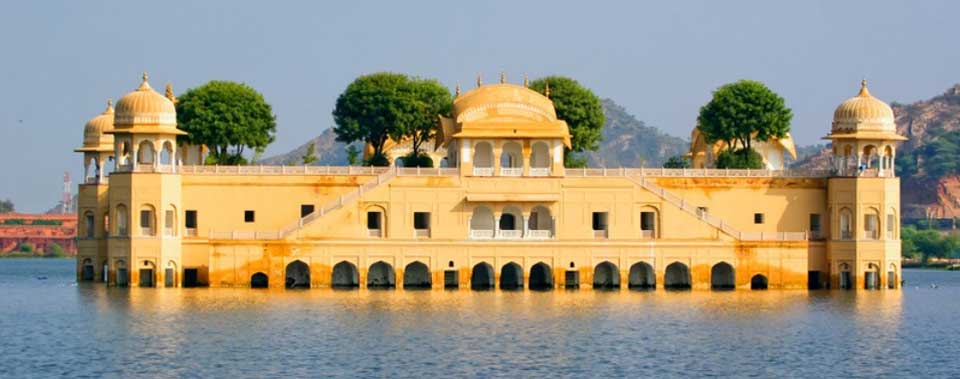Famously known as the Pink City, Jaipur is the capital of Rajasthan, the largest Indian state situated in the North-Western region of India. One of the top tourist destinations in India, the vibrant city of Jaipur is a prime attraction of tourists for its amazing royal heritage as well as its colorful culture and traditions. Surrounded by the hilly terrain of Aravali range, the city is situated on the periphery of the Thar Desert around 280 km away from Delhi, the National Capital of India. The beauty of Jaipur lies in its distinguished character which is the perfect muddle of quaint and contemporary architecture, culture and traditions. The city is the showcase of ageless magnificent forts and palaces, quaint local markets, along with the modern colonies, bustling malls and food courts.
One of the important cities of the medieval era, the city of Jaipur was established by the King Jai Singh II in the year 1727. Jai Singh II was the ruler of Amer during 1699 and 1744 when he shifted the capital from Amer to Jaipur to accommodate the growing population. The scarcity of water at the Amer, which is located around 11 km from the Jaipur city, was the prime reason to shift the capital. The architecture of the Jaipur city was developed after a long research on architecture and Vastushastra and then the construction of the city started in the year 1726 and completed after the four years. The palaces, royal offices, major roads and entry gates were constructed within four years. The city was divided into the nine blocks among which two blocks are the royal blocks which contain the palaces, state buildings and offices whereas the remaining 7 blocks were allotted to the public. Also, the seven massive gates were built for the entry into the Jaipur city.

The city was named after the King Maharaja Jai Singh II. The Buildings of the Jaipur city were colored in the Pink color during the reign of King Sawai Ram Singh I in the year 1876 to welcome the Prince of Wales. Later, this distinct pink color of the whole city became the identity of the Jaipur city and known as the pink city of India. The prime tourist attractions of the Jaipur are the Jantar Mantar Observatory, Amber Fort, Jaigarh Fort, Nahargarh Fort, Hawa Mahal, Jal Mahal and City Palace along with the famous temples such as Birla Mandir, Garh Ganesh Temple, Galtaji Temple, Govind Dev Ji Temple, Moti Dungri Ganesh Temple and Sanghiji Jain temple. The Amber Fort and the Jantar Mantar are the UNESCO world heritage sites in Jaipur. The grandeur of the Forts and Palaces are the testimony of the glory and valor of the rulers of the Jaipur Kingdom.
The Jaipur is one of the three destinations of the famous Golden Triangle tour circuit of India. The three historical cities Delhi, Agra and Jaipur geographically makes the triangle and known for the high tourist visit due to the rich and diverse historical, cultural and architectural heritage. Jaipur is also an essential stopover and a base hub for the Rajasthan tour. The journey to various other tourist destinations in Rajasthan starts from Jaipur as the city has the International Airport, Interstate Bus Terminal and a most important railway junction which is located on the main line of the Northwestern railway. Jaipur is also an important hub for the traditional handmade garments, street style fashion clothes, designer jewelry and beautiful handicrafts. The traditional garments with mirror works and hand embroidery are irresistible to buy. The folk music and folk dance which performed live at different places in Jaipur are amazing to grab your attention.
Major Sightseeing in Jaipur :
Amber Fort:
Nestled amidst the hills of the Aravalli range, the Amber Fort is a UNESCO world heritage site and among the prime tourist attractions in the Rajasthan. Also known as the Amber Palace or Amer Palace, the foundation of the Fort was laid by the King of Amer Man Singh I. The Fort later completed by the King Jai Singh. Set amidst the picturesque location, the Palace was built with the red sandstone and white marble which makes it one of the beautiful Forts in India. The beautiful sight of the sunrise and sunset from this fort overlooking the Maota Lake is simply outstanding. The fort is fortified with the walls strong enough to defend its residents of the fort from the attacks of the enemies. Inside the Amber Fort, the Sheesh Mahal, means the palace of mirrors, is one of the prime attractions which will captivate with its beauty. The hall was decorated with the various mirror tiles in such a way that just a single sunray illuminates the whole hall.


Agra Fort:
Build by the Mughal Emperor Akbar, the Agra Fort was the prime residence of the Royals of the Mughal dynasty till 1638. This historical fort is located in the city of Agra nearby the famous monument of Taj Mahal in India. Till the capital of the Mughal Empire was shifted to Delhi in the year 1638, the Agra Fort was the power center of the Mughal Empire. A UNESCO world heritage site, the fort of Agra is also known as the Red Fort of Agra which was constructed as an invincible military base by the then Mughal Emperor Akbar. Later, many structures were built in the Fort by the son of Akbar, the Emperor Jehangir and also modified extensively by the Emperor Shah Jahan, son of Jehangir. The Fort is situated around 2.5 km northwest of the Taj Mahal and known as the walled city due to its mammoth size. The Fort of Agra with all of its elegance, lavishness and splendor of the Mughal era is considered one of the finest imperial palace in India.
Hawa Mahal:
This amazing palace was built by Maharaja Sawai Pratap Singh in the year 1799, specially designed for the ladies of the Royal family to watch the activities on the road below such as processions, festivals, etc. and enjoy the view. The Hawa Mahal is among the prime attractions of Jaipur and becomes synonymous with the Jaipur tourism. The palace is a 5 storied massive building with having 152 windows in the spectacular semi-octagonal design. It is the perfect example of spectacular Rajput architecture. At present, the palace has been converted into an enriched museum, which showcases the glittering heritage of Jaipur.
Jantar Mantar Observatory :
Declared a UNESCO world heritage site, the Jantar Mantar was built by the Maharaja Sawai Jai Singh II in the 18th century. This observatory had the massive masonry instruments which were used to research on the stars and constellations in the sky and study their movements. The giant sundial here is the world’s largest stone sundial. The Jantar Mantar of Jaipur is the largest among the five Jantar Mantar built by Maharaja Sawai Jai Singh II.
City Palace :
Nestled in the center of the old city of Jaipur, the City Palace occupies around 14 percent of the total area of the old city. Designed with the Rajput and Mughal architectures, the palace has a seven-storied building in the center which is known as the Chandra Mahal. The Chandra Mahal offers an outstanding panoramic view of the gardens and the entire old city. Other structures such as Diwan-E-Aam (Hall of public audience), Diwan-E-Khas (Hall of private audience), Mubarak Mahal, SilehKhana, etc. has its own charm and grandeur with the intricate decorations and collections.
Jal Mahal:
Situated in the middle of the Man Sagar Lake, the spectacular palace named JALMAHAL is a tourist attraction which must be visited while in Jaipur. A perfect example of grandeur and beauty of the Rajput architecture, the palace is located at around 6 km from Jaipur on the way to Amer.
Apart from the above prime tourist attraction, there are plenty of heritage and destinations, visiting where will be an enriching experience. The Jaigarh Fort, Nahargarh Fort, Gaitor, Sun Temple at Galta, Laxmi Narayan Temple, Kanak Vrindavan, Motidoongari, Maharani Ki Chhatri, Sisodia Rani Garden, Vidhyadhar Garden, Ishwar Lat or Swarg Suli, Central Museum of Jaipur, Birla Planetarium, etc. are the destinations in Jaipur which attracts tourists. You should also visit these places to understand the enriching past and present of the Jaipur city.

Best Time to Visit
Though the tourists used to visit Jaipur round the year without any hassle and Jaipur welcome them warmly, but the winter season is the time when the Pink city is flooded with the tourists. From the month of October to the March is considered as the best time to visit this city as well as other cities of this desert state. The pleasant weather and vibrant festivals in Rajasthan attracts tourists from all over the world during the winter season. Being a desert state, the summer season is extremely hot in the scorching sun, making it very difficult to go out for sightseeing during the daytime. The monsoon season is somewhat better than the summers, but the atmosphere is still hot due to the meager rainfall. Also, the winter season is the time of many festivals such as Diwali, Kite festival, Elephant festival, Holi, Jaipur Literature Festival, Gangaur festival, etc. which will make your tour more enjoyable and enriching.
If you visit Jaipur during the summer season, from April to June then you must be careful about the excessive heat and harsh sunlight. You should keep yourself hydrated to prevent dehydration in the hot weather. It is wiser to stay at your hotel during the daytime and go for the sightseeing in the evening. The monsoon season, from July to September, is the time when tourists started visiting in Jaipur as the weather brings some relief from the summer heat. However, there is no such a heavy rush of tourists in monsoon as like in winter, one can get good hotels and tourist services at a lesser price than winter. So, if you can bear little hot weather than you can visit Jaipur in the monsoon to put a lesser burden on your pocket.
How to Reach
Jaipur is among the most popular tourist destinations in India so this Pink city is well connected with Delhi, the National Capital of India as well as other major towns and cities of India. The airways, railways and roadways – all three modes of transport are available to reach Jaipur easily from any corner of India and Abroad. Below is the detailed info about how to reach Jaipur via air, rail and road -
By Flight :There is an International Airport, located in Jaipur itself in the Sanganer around 10 km from the Jaipur city, also known as the Sanganer Airport. The Jaipur Airport receives a large number of domestic flights and international flights regularly. The domestic flight connecting major cities of India like Delhi, Mumbai, Kolkata, Jodhpur, Udaipur, Ahmedabad and numerous others are available on a regular basis. The frequent international flights are available to and from Singapore, Bangkok, Dubai, Muscat, etc. as well as many other flights operated with some interval. You can easily reach Jaipur through the direct flights or the connecting flights from any corner of the world.
By Train :The Jaipur Railway Station is one of the busiest railway stations in India and also the Jaipur is the zonal headquarter of the North-West Indian Railway Zone. The railway station of Jaipur is well connected to other parts of India through the regular trains. Other major cities of India such as Delhi, Mumbai, Kolkata, Chennai, Hyderabad, Bengaluru, Ahmedabad, etc. connect Jaipur with the direct express trains. Apart from the regular express trains, a special train for tourists "The Palace on Wheels" is an added attraction that offers a royal train ride, a palace like facilities on the wheel, to visit Jaipur.
By Road :The city of Jaipur connects major cities nearby through the National Highways. The National Highway No. 8 (NH-8) that connects Delhi and Mumbai crosses through the city of Jaipur while the NH-11 that connects Bikaner and Agra passes through Jaipur, and also the NH-12 also passes through Jaipur which connects this city to Kota. The Rajasthan State Road Transport Corporation (RSRTC) operates various luxury and deluxe, AC and Non-AC buses on a regular basis between Jaipur and other cities within the Rajasthan state as well as the neighboring states such as New Delhi, Uttar Pradesh, Madhya Pradesh, Haryana, Punjab, Maharashtra and Gujrat. The regular buses run from Jaipur to Udaipur, Kota, Ajmer, New Delhi, Mumbai, Ahmedabad, Vadodara, etc. at an affordable fare.